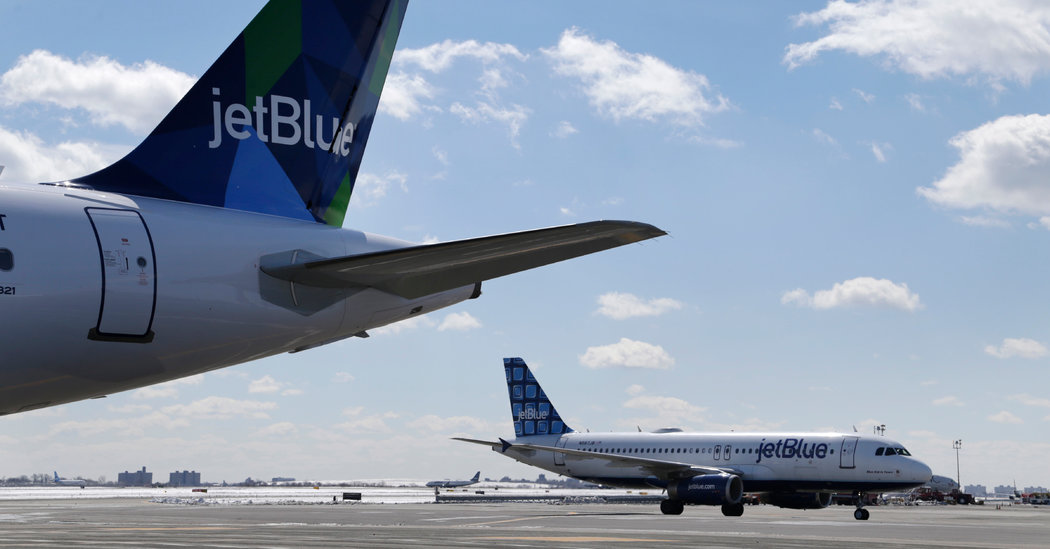
JetBlue Airways, the New York-based low cost carrier, announced on Wednesday that it would begin flying across the Atlantic Ocean, from London to Kennedy International Airport and Boston Logan International, in 2021.
The company’s chief executive Robin Hayes said the new routes are a response to passenger demand.
JetBlue is known for having a loyal customer base, but entering the hypercompetitive trans-Atlantic market is still likely to be a challenge. The three major airlines in the United States — American Airlines, Delta Air Lines and United Airlines — have multiple flights each day between the East Coast and Britain. The market is further crowded by two British carriers and low-cost Norwegian Air.
“This is not going to be an easy win for JetBlue,” said Henry Harteveldt, the founder of Atomosphere Research Group, an industry analysis firm. “The big airlines especially are going to bring flamethrowers to a game of rock-paper-scissors.”
Mr. Harteveldt expects these airlines already flying between the East Coast and London will strongly compete with JetBlue on price. Many of the more established carriers will be at an advantage, he said, as they have more daily flights and more capacity than JetBlue will, which ultimately means more flexibility for their passengers. But increased competition is still a boon to fliers.
“Travelers always win when there are more airlines,” Mr. Harteveldt said, “It forces airlines to compete as opposed to taking that business for granted.”
These airlines have another incentive to make it difficult for JetBlue, he added.
“If JetBlue becomes successful, then the large airlines are going to fear that another airline, whether it’s low cost or ultralow cost,” will try the same thing and further split the market, Mr. Harteveldt said. “We will probably see them over-respond to whatever JetBlue does.”
But JetBlue is confident that it will find success in the trans-Atlantic market and will bring lower prices to those routes, too.
“We have a very strong customer base in both New York and Boston and we get asked about this a lot,” Mr. Hayes said. “We think we can offer lower fares and stimulate additional demand.”
JetBlue plans to have multiple flights each day on the new routes, but Mr. Hayes declined to discuss the airfare for those flights. Few other details of the service were announced, including which airport, or airports, JetBlue planes will land at in London.
With the expansion across the pond, JetBlue is particularly focused on making premium cabins affordable for more fliers.
“We see obscene fares across the Atlantic,” Mr. Hayes said. “People will be paying a lot less for a business class experience than they pay today.”
Premium airfares on transcontinental flights in the United States declined, he noted, after JetBlue in 2014 introduced its “Mint” cabin, which featured lie-flat business class-like seats.
“We were selling from $599, and the average fares across the continent in premium have halved since we started flying.” Mr. Hayes said, adding that the airline plans to update its Mint cabin for trans-Atlantic service.
(JetBlue is no longer necessarily the cheapest airline for premium transcontinental flights: For a weekend trip to San Francisco from New York in May, JetBlue’s Mint costs around $2,000, compared to about $1,320 for the same dates in business class on American Airlines.)
JetBlue’s fleet could also be a competitive advantage. The airline ordered 13 Airbus A321neo long-range variants — a narrowbody jet with capacity for fewer passengers than the larger planes other airlines fly on many trans-Atlantic routes. That means the airline will require fewer tickets to be sold than their competitors to be profitable.
Mr. Hayes added that the long-range A321neo could ultimately open more routes that other airlines currently serve with planes like the Airbus A350 or Boeing 787, including more European cities like Dublin, Paris and Amsterdam. Mr. Harteveldt agreed the planes were an advantage to the airline.
“If London proves to be unprofitable, if JetBlue can’t make it, those A321LRs can be deployed elsewhere.”
52 PLACES AND MUCH, MUCH MORE Follow our 52 Places traveler, Sebastian Modak, on Instagram as he travels the world, and discover more Travel coverage by following us on Twitter and Facebook. And sign up for our Travel Dispatch newsletter: Each week you’ll receive tips on traveling smarter, stories on hot destinations and access to photos from all over the world.






